Chionanthus
Guest Author: Susan Mintun
The genus Chionanthus (pronounced ki-o-nan-thus, with a long i) offers gardeners in this area two species of large shrubs to small trees that can make lovely additions to our gardens. It is most often called fringetree or old man’s beard. The common names, as well as the Latinized genus name, refer to the flowers.
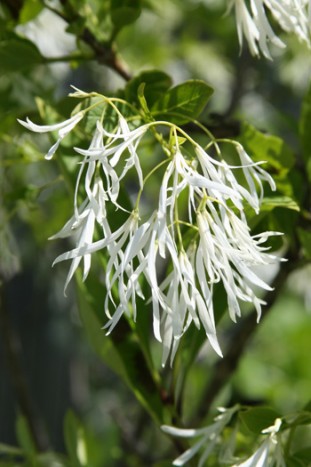
Chionanthus virginicus is covered in delicate, tassel-like, fragant blooms in the spring. photo credit: S. Mintun
Chionanthus comes from Greek; chion, meaning snow, and anthos meaning flower. In spring, these plants can be covered with delicate, tassel-like, fragrant blooms. There is some disagreement among taxonomists exactly which plants should be placed in the genus Chionanthus. Some authorities recognize about 100 species, while others place most of these plants, which are tropical and subtropical evergreens in the genus Linociera. But no matter; for our gardens, two temperate deciduous species, C. virginicus and C. retusus, are of greatest interest.
Chionanthus virginicus is one of our nicest native plants, found naturally in the southeastern United States (hence the specific epithet virginicus), but it is certainly hardy to at least zone 4. In nature, it is generally found as an understory plant in moist, acidic, fertile soils, but it is quite adaptable, making it a good candidate as a specimen shrub or small tree.
This species flowers on the previous season’s wood just as the leaves are reaching full size, and the overall effect is a charming color combination of fresh, bright green and pure white. The individual flowers are fairly small, but are lightly fragrant and produced on panicles that nod gracefully, creating a lacy texture and emitting a gentle scent.
The common name, fringetree, is apt because the four petals on each flower are very narrow and only about an inch long. The plants are polygamous, meaning they have separate male and female flowers, though in this genus both sexes often occur on the same plant. The male flowers are somewhat showier than the females because their petals are longer, but the ornamental difference between the two is slight. For those of you who are botany-minded it is a fun exercise to locate male and female samples and compare them side by side .
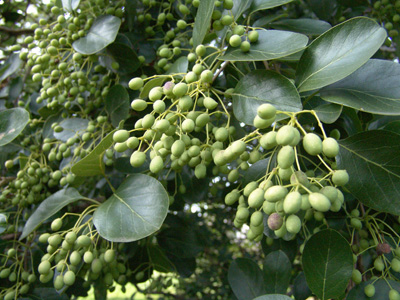
Chionanthus retusus 'Serrulatus' has an impressive display of green drupes in August. photo credit: R. Maurer
In August, the female flowers develop green drupes that ripen to a beautiful dark, dusky blue relished by birds. The fruits are reportedly edible for humans, too, especially if pickled (Chionanthus is a member of the olive family, Oleaceae) though I have never tried them. Throughout the season the oppositely arranged, entire leaves remain clean and attractive, with little interference from diseases or insects. Fall color can be a nice yellow on some individuals, though generally muted yellow to brown is the norm.
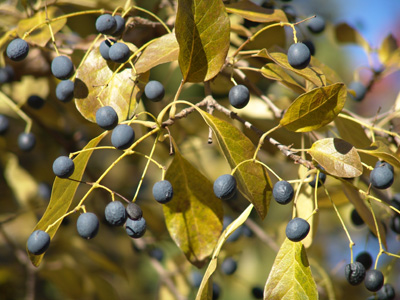
Chionanthus retusus has nice fall color and the green drupes ripen into a lovely dark, dusty blue. photo credit: R. Maurer
Chionanthus retusus is native to China and thus sometimes called Chinese fringetree. The specific epithet refers to the leaf shape of this species, which is often (though not always) notched at the tip and usually more rounded than the leaves of C. virginicus. In many respects the two species are similar, but a major difference is that C. retusus blooms on new wood at the tips of the branches and before the foliage is fully developed. In addition, the panicles are more upright, so the result is that the flowers are not partially obscured by the leaves as they are on C. virginicus. By the same token the lovely green to rose to bloomy blue-black fruits are also easier to admire (photo 4). In years when the flowers are produced in large numbers, the rest of the tree will be all but hidden by masses of delicate, fragrant flowers. If the weather is not too harsh the flowers can last for as long as two weeks. I recall being utterly astounded one spring when, rounding a bend in Central Park in New York City, I encountered a grove of Chinese fringetrees in full bloom; the sight was breathtaking . I need to return some day to see those trees in fruit. I’ll just have to get there before the birds. In winter the bark pattern is quite attractive – dark vertical stripes interspersed with silver-gray plates .
Cultural considerations: Placed in full sun the growth habit will be denser and flowering more abundant than if the plant receives partial shade. Both species exhibit a fair amount of variability in form, size, and leaf shape, especially depending on northern or southern provenance. Plants may develop into a rounded shrub or can be encouraged into a more tree-like form with careful pruning and age. They are slow-growing, and generally reach about 20’ tall. If you have a difficult site, this may be a plant worth trying.
In my experience, C. virginicus is not just cold hardy, but tough as nails in many respects. I have seen it grow and bloom in a hot parking lot island with its roots in nasty construction soil, and also soldier along in highly compacted soil. Though I certainly don’t recommend this type of unkind treatment, sometimes it just can’t be helped. A small plant I received from Michael Dirr many years ago survived travel, a couple of transplants, and rubbing by male deer before finally finding a permanent home in my St. Louis garden. Despite tribulations it flowered at a young age and was about 10’ tall after 14 years. I have not tested C. retusus in such extreme conditions, but those I have grown have been very reliable. Nursery growers recommend planting in spring.
If you enjoy horticultural challenges you might want to try propagating some fringetrees. I have had fairly good luck starting C. virginicus from seed, though they take about 18 months to germinate and exhibit double dormancy. I have attempted both species from cuttings without much success. Experts suspect that using juvenile tissue is key, and since the plants flower at a young age having a source of juvenile cuttings can be an issue. Fringetrees can also be propagated by layering, though I have not tried it. There are a number of online articles from knowledgeable growers that detail all three methods.
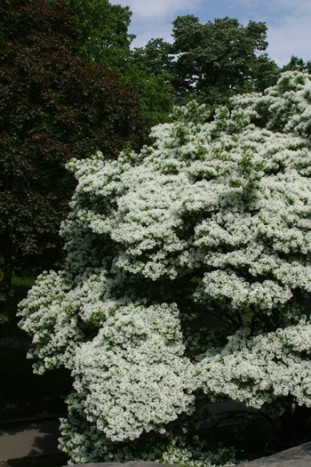
I recall being utterly astounded one spring when, rounding a bend in Central Park in New York City, I encountered a grove of Chinese fringetrees in full bloom; the sight was breathtaking. photo credit: S. Mintun
Also noted
Chionanthus pygmaeus, dwarf fringetree, is an intriguing species native to Florida. It is similar to C. virginicus, though smaller in stature, reaching only about 4’ tall, and is therefore a good choice for small gardens. I have never grown it, but I would certainly like to. It is adapted to harsh, dry environments and exhibits the same ornamental qualities as other fringetrees, so like C. virginicu, could be a good choice for tough spots. Sadly, the species was placed on the endangered list in 1987 due to loss of habitat from commercial, residential, and citrus grove development in Florida. Scott Arboretum is fortunate to have three dwarf fringetrees in its collection.
Susan Mintun is a transplanted teacher and horticulturist who moved to Philadelphia in 2011. She served on the faculty and curated the plant collections of the Horticulture Department at Meramec College in St. Louis for many years before her husband’s job brought them back to this area. She holds undergraduate degrees in Fine Art, Business and Horticulture, and a Master’s degree in Plant Science from Washington University in St. Louis. Susan is thrilled to be back in the city where she grew up! She is enjoying rediscovering all the area has to offer and volunteering her time at the Scott Arboretum of Swarthmore College. She has two perfect children, both in college, the world’s best dog, and two spoiled cats. She and her husband, Mark, live in Villanova.






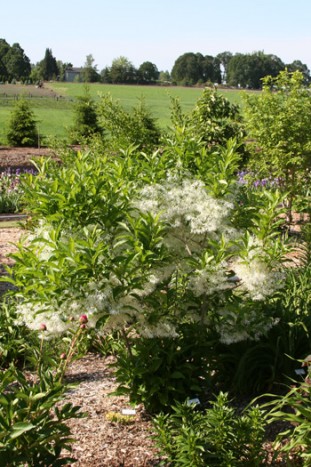
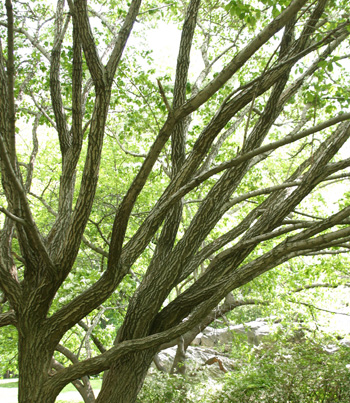
Lynn Rogers
Posted at 18:57h, 24 FebruaryHave you seen the difference between the
Southern & Northern forms? Their leaves are different.
There are separate male and female trees.
Andrew Bunting
Posted at 10:35h, 25 FebruaryYes, there are male and female plants with Chionanthus virginicus. Can you clarify what you mean by southern and northern forms?
Andrew Bunting, Curator
JB
Posted at 15:43h, 09 MayI think the northern populations have lighter green, thinner leaves- and are more shrubby. Plants originating from the south have a faster, sturdier, tree-like habit. The leaves seem to be a darker green and thicker.
The same thing with habit can be seen with sweetbay magnolia.
-Jimmy
Tia
Posted at 17:42h, 12 AugustI have been looking for an interesting, stand-alone, tree to be planted on a sloping driveway down towards the front entrance of our home in northern NJ as a beautiful welcoming display and this plant/tree was suggested to me by a horticulturalist. Do you believe this tree is suitable for my purposes? I appreciate any advice you can give and/or any other tree suggestions. I am looking for mid-size to taller trees with interesting bark and Spring/Fall showy colors which are hardy to northern NJ.
Thanks in advance!
-Tia
Marvin Miller
Posted at 09:02h, 03 SeptemberI am interested in finding a recipe to pickle the fruit from a fringe tree. Do you have any? We were pleased to visit the campus of Swarthmore last spring and enjoy your lovely gardens. My daughter in law, Andrea Wong is a graduate of Swarthmore.
Thanks,
Marvin Miller
Bonnie Burkert
Posted at 09:49h, 10 MayHope someone has heard of this weird problem. I have an approximately 20 year old Chinese Fringe tree that we love in the spring for it’s flowers and wonderful scent. This year, the tree is blooming and looks perfectly healthy but the flowers have no scent! It’s not just me – I had a couple other opinions on this. Any idea why or if it will come back? I’m in Wilmington, DE.
Becky Robert
Posted at 12:37h, 11 MayHello Bonnie, I am Lars Rasmussen, Assistant Plant Supervisor for Plant Health at Swarthmore College. I have never heard of a fragrant tree’s flowers not having a smell for one year. I have noticed that fragrance levels can vary through the day depending on temperature. Otherwise I can not think of a reason why that would happen. Of course many plants can lose fragrance in the breeding process but that does not apply here. If I see this happening elsewhere I will be in touch. -Lars
Mark Mickey
Posted at 17:54h, 11 SeptemberWill it grow ok in clay type soil, live in little mountain area of south carolina